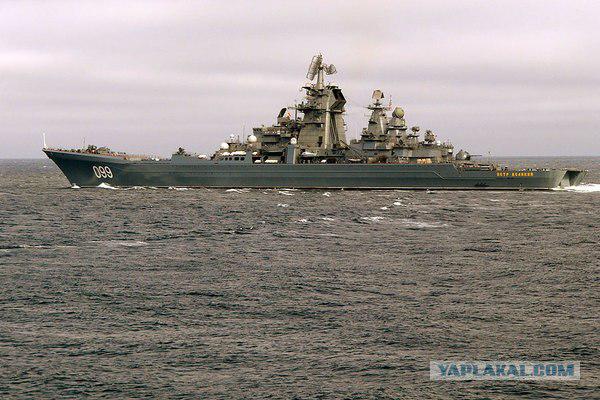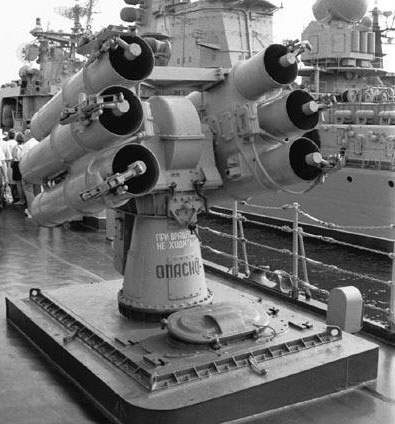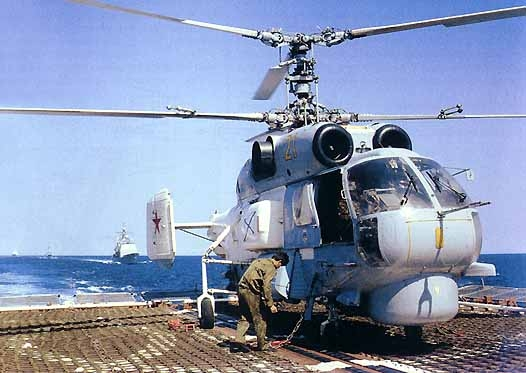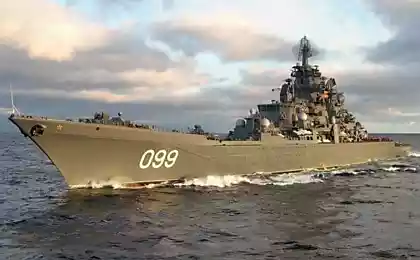769
"Peter the Great" 8 fott
Appointment
Heavy nuclear missile cruiser (TARKR) "Peter the Great" is designed to engage large surface targets, protection of marine compounds from air attacks and enemy submarines in remote areas of the oceans and seas.

History of
In 1964 he began designing domestic surface ships having a virtually unlimited range of travel. Originally it was planned to create a 8,000-ton anti-submarine with a nuclear power plant. However, by the end of the 60s submarines with intercontinental missiles of the US Navy with nuclear power plants go into the ocean and becomes virtually invulnerable. To deal with them in order to prevent a nuclear strike in the Soviet Navy created task forces anti-submarine ships, capable of carrying on combat duty in the identified areas of attack submarines patrolling the probable opponent. In turn, ensure the stability of the ship's anti-militant groups demanded the creation of a larger multi-purpose cruiser unlike previously projected. Thus was born Project 1144 heavy nuclear missile cruiser.
TARKR "Peter the Great", the great-grandson of battleships and battle cruisers era "of armor and shells" - the last ship of Project 1144 "Orlan" is a further development of shock missile cruisers, including cruisers pr.1164. Unlike their predecessors TARKR has enhanced cruising, equipped with a more efficient means of sonar, antisubmarine weapons and cruise missiles. Analogues abroad do not have: the American cruiser nuclear power plant such as "Virgin" in displacement 2.5 times less, and the cruiser "Lone Beach" 1.5. Create ships of this class was one of the most significant achievements of the domestic shipbuilding XX century.

Specifications and equipment
The total displacement of the ship for more than 26 000 tonnes. The team: 727 people. Flight staff: 18 people. The main weapon - anti-ship cruise missiles "Granit". Zenith, shock, anti-submarine cruiser weapons allows to solve almost any combat missions. Add-ons are a lot of radar antennas and early warning systems. Missile launchers lie ahead, below deck, leaving the stern section to the main propulsion system and a helicopter hangar.
The main power plant has two reactors on fast neutrons of thermal capacity of 300 MW and two auxiliary oil boilers. Pairing nuclear reactors to oil superheaters increases the total capacity of the plant, and thus the speed of the ship.
The two shafts rotate two five-blade propeller.
The technical complex nuclear power plant comprises in addition to the reactor, which is provided by the energy conversion of nuclear fission to heat a whole set of complex and critical manufacturing equipment - pumps, steam generators, control systems of the reactor and power plant, turbine and gear, filters, heat exchangers, compressors, various appliances and others.
To ensure the operation of a ship NEI additionally required: a specially equipped base with a number of shore-based, special tools and equipment for loading and unloading fresh spent fuel, collection, storage and processing of solid and liquid radioactive waste, etc.
Armament
The basis of the weapons Tarka make anti supersonic missiles "Granit" P-700 (3M-45), is the development of PRK "Basalt". In the west missiles Granite codenamed "Shipwreck". With a starting weight of 7 tons. Missile has a maximum speed of 2, 5 M and can deliver explosive fragmentation warhead weighing 750 kg or a nuclear warhead up to 500 kt at a distance of 600 km.
The rocket is designed to deal with carrier strike groups (CSGs) and is able to act not only against the United ships of all classes in the course of armed conflicts of any intensity, but also effectively hit targets on the coast of the usual enemy warhead. If necessary, ships with a set of "Granit" can be the reserve solving naval strategic nuclear forces.
Initially, missile complex "Granit" armed with 12 nuclear submarines of the project 949A of "Antey", 24 on each RCC, with a submerged speed of 30 knots.

On TARKR pr.1144 twenty RCC "Granite" installed under the upper deck, with an elevation angle of 60 degrees. Modification RCC "Granite" installed in ships of the project 1144.2 is not controlled after launch. In the runaway fire one missile that serves as a "gunner" is flying at a high trajectory to maximize the area of the target lock, while other missiles fly at a low trajectory. In flight, the rocket exchange information on purpose. If the rocket - "gunner" intercepted, then one of the other missiles automatically takes over its function. The missile system is stable with respect to radio interference opponent.
The experience of combat and operational training of the Navy to shoot down a missile is virtually impossible. Even if you hit the "Granite" antimissile missile because of its huge mass and velocity can save the initial airspeed and thus reach the goal.

The ship's combat systems TARKR include:
combat information center; radio system; satellite communication system;
fire control system RCC complexes RBU-1000 and "Boa-1";
radiolakatsionnye station: surveillance radar, the radar detection of low-altitude and surface targets, naval fire control radar air defense systems - 2 units., fire control radar 30mm gun mounts - 4 units., Navigation Radar - 2 pcs .;
as well as active and passive acoustic systems and electronic measuring system.
Anti-air defense missile and artillery armament "Perth Great" includes S-300F, air defense system "Dagger" SAM "Dirk" with AK-630 and AK-130 gun mount.
SAM "Fort-M" in contrast to his predecessor - anti-aircraft complex "Fort", able to fire up to 6 targets simultaneously at a distance of 120km and successful fight against anti-ship missiles at altitudes of up to 10 meters. Expansion of the affected area is achieved by improving the energy characteristics of the transmitter and the sensitivity of the receiving channels.

Surface-to-air missile 48N6E2 (it unified with the overland S-300PMU-2) with a vertical start has improved propulsion system and enhanced warhead. Rocket - remote-controlled, semi-active homing in the terminal phase of flight. Delivered on a transport ship - launch canister. Maximum range - 200 km.
On the cruiser "Peter the Great", an additional set of the nasal system S-300FM "Fort-M." Thus, armed with TARKR one S-300F with 48 missiles 48N6 and one S-300FM with 46 missiles 48N6E2.
On TARKR "Peter the Great" instead of anti-system, "Osa-MA", established earlier pr.1144 ships and cruisers pr.164 installed complex "Dagger" with improved performance characteristics. SAM "Dagger" - a multi-channel, vsegopodny, autonomous air defense missile system near defense, capable of reflecting massive raid low-flying anti, anti-radar missiles, guided and unguided bombs, planes, helicopters, etc. Adopted in 1989 on armaments. large anti-submarine ships, etc.. From 1155 heavy cruisers "Dagger" is set as the "Admiral Kuznetsov". Abroad comes under the name "Blade".

Complex "Boa-1" is equipped with 40 anti-submarine missiles. A similar system has a heavy aircraft carrier "Admiral Kuznetsov".
RBU-1000 form the basis of Cyclone-3 having the following composition: 2 shestitrubnyh remotely suggestive of anti-missile PU RBU-1000 (ammunition 102 missiles), charger, depth charges RSL-10 with fuse GWU-60 system PUSB "The Tempest" with prefix "Buzzer", fire control up to four RBU. The reaction time after detecting submarines before shooting 1-2 minutes. The range of the system is 1km.
Earlier cruisers drum samples (including pr.1164) have a system Smerch-2 RBU-600.

For the anti-protection are also three Ka-27PL or Ka-25RT
The Ka-27 is known in the West as "Helix" and is equipped with anti-submarine weaponry, including a search radar, sonobuoys, acoustic systems and magnetic anomaly detectors. Ka-27 can be armed with torpedoes, bombs, mines and RCC. Ka-25, known in the West under the name of "Hormone" is the predecessor of the Ka-27.
TARKR "Peter the Great" - the world's largest neavianesuschy shock warship. "Peter the Great" as well as other ships of the "eagle" was designed as a strike cruiser for superiority at sea. Although pr.1144 nuclear cruiser "Orlan" for a number of years been the world's best ships in their class, a number of specialists have to admit the project failed. According to them, in order to counter the modern anti-ship missiles, aircraft guns and bombs of small caliber, the ship should be equipped with at least a minimal armor protection. The ship did not have enough firepower and autonomy. Real "Orlan" can handle any of the extremely unfortunate postwar American cruisers, but absolutely defenseless against aircraft carrier compound or modernized American battleships type LOWA.
Thus, there is the view that the "Eagle" is not able to win a rivalry for supremacy on the sea. Maintaining its good technical and combat readiness requires large capital investments. Thus, as noted above, the nuclear power plant cooldown unique operation with sophisticated infrastructure, which has not set up properly due to lack of funds.
Perhaps that such assessments lead to the conclusion that the presence of ships of class "Orlan" does not provide for the concept of development of the Russian Navy until 2015. The validity of these findings confirm or refute the story. In a place so all the possible negative effects of the project with the proper organization on the state level the subsequent operation of "Peter the Great" can be significantly reduced, which in turn can provide an opportunity to return to the combat strength of the other ships of the project "Orlan".
Key Features TARKR "Peter the Great"
-
Crew 760
Displacement, t
Standard - 24,300
Full - 26,190
Cruising range, miles
on the aux. turbines - 1000
at the NPU - not an ogre.
The rate bonds.
full speed - 31
economical - 18
Endurance, days. 60
Main propulsion
nuclear reactor - 2hKN 3
steam turbine GTZA hp - 2x70 000
gas turbine, kW - 4 × 3 0000
gas TG, kW - 4 × 1500
Overall dimensions, m:
Length - 251
width - 28.5
sediment - 10.3

Source:
Heavy nuclear missile cruiser (TARKR) "Peter the Great" is designed to engage large surface targets, protection of marine compounds from air attacks and enemy submarines in remote areas of the oceans and seas.

History of
In 1964 he began designing domestic surface ships having a virtually unlimited range of travel. Originally it was planned to create a 8,000-ton anti-submarine with a nuclear power plant. However, by the end of the 60s submarines with intercontinental missiles of the US Navy with nuclear power plants go into the ocean and becomes virtually invulnerable. To deal with them in order to prevent a nuclear strike in the Soviet Navy created task forces anti-submarine ships, capable of carrying on combat duty in the identified areas of attack submarines patrolling the probable opponent. In turn, ensure the stability of the ship's anti-militant groups demanded the creation of a larger multi-purpose cruiser unlike previously projected. Thus was born Project 1144 heavy nuclear missile cruiser.
TARKR "Peter the Great", the great-grandson of battleships and battle cruisers era "of armor and shells" - the last ship of Project 1144 "Orlan" is a further development of shock missile cruisers, including cruisers pr.1164. Unlike their predecessors TARKR has enhanced cruising, equipped with a more efficient means of sonar, antisubmarine weapons and cruise missiles. Analogues abroad do not have: the American cruiser nuclear power plant such as "Virgin" in displacement 2.5 times less, and the cruiser "Lone Beach" 1.5. Create ships of this class was one of the most significant achievements of the domestic shipbuilding XX century.

Specifications and equipment
The total displacement of the ship for more than 26 000 tonnes. The team: 727 people. Flight staff: 18 people. The main weapon - anti-ship cruise missiles "Granit". Zenith, shock, anti-submarine cruiser weapons allows to solve almost any combat missions. Add-ons are a lot of radar antennas and early warning systems. Missile launchers lie ahead, below deck, leaving the stern section to the main propulsion system and a helicopter hangar.
The main power plant has two reactors on fast neutrons of thermal capacity of 300 MW and two auxiliary oil boilers. Pairing nuclear reactors to oil superheaters increases the total capacity of the plant, and thus the speed of the ship.
The two shafts rotate two five-blade propeller.
The technical complex nuclear power plant comprises in addition to the reactor, which is provided by the energy conversion of nuclear fission to heat a whole set of complex and critical manufacturing equipment - pumps, steam generators, control systems of the reactor and power plant, turbine and gear, filters, heat exchangers, compressors, various appliances and others.
To ensure the operation of a ship NEI additionally required: a specially equipped base with a number of shore-based, special tools and equipment for loading and unloading fresh spent fuel, collection, storage and processing of solid and liquid radioactive waste, etc.
Armament
The basis of the weapons Tarka make anti supersonic missiles "Granit" P-700 (3M-45), is the development of PRK "Basalt". In the west missiles Granite codenamed "Shipwreck". With a starting weight of 7 tons. Missile has a maximum speed of 2, 5 M and can deliver explosive fragmentation warhead weighing 750 kg or a nuclear warhead up to 500 kt at a distance of 600 km.
The rocket is designed to deal with carrier strike groups (CSGs) and is able to act not only against the United ships of all classes in the course of armed conflicts of any intensity, but also effectively hit targets on the coast of the usual enemy warhead. If necessary, ships with a set of "Granit" can be the reserve solving naval strategic nuclear forces.
Initially, missile complex "Granit" armed with 12 nuclear submarines of the project 949A of "Antey", 24 on each RCC, with a submerged speed of 30 knots.

On TARKR pr.1144 twenty RCC "Granite" installed under the upper deck, with an elevation angle of 60 degrees. Modification RCC "Granite" installed in ships of the project 1144.2 is not controlled after launch. In the runaway fire one missile that serves as a "gunner" is flying at a high trajectory to maximize the area of the target lock, while other missiles fly at a low trajectory. In flight, the rocket exchange information on purpose. If the rocket - "gunner" intercepted, then one of the other missiles automatically takes over its function. The missile system is stable with respect to radio interference opponent.
The experience of combat and operational training of the Navy to shoot down a missile is virtually impossible. Even if you hit the "Granite" antimissile missile because of its huge mass and velocity can save the initial airspeed and thus reach the goal.

The ship's combat systems TARKR include:
combat information center; radio system; satellite communication system;
fire control system RCC complexes RBU-1000 and "Boa-1";
radiolakatsionnye station: surveillance radar, the radar detection of low-altitude and surface targets, naval fire control radar air defense systems - 2 units., fire control radar 30mm gun mounts - 4 units., Navigation Radar - 2 pcs .;
as well as active and passive acoustic systems and electronic measuring system.
Anti-air defense missile and artillery armament "Perth Great" includes S-300F, air defense system "Dagger" SAM "Dirk" with AK-630 and AK-130 gun mount.
SAM "Fort-M" in contrast to his predecessor - anti-aircraft complex "Fort", able to fire up to 6 targets simultaneously at a distance of 120km and successful fight against anti-ship missiles at altitudes of up to 10 meters. Expansion of the affected area is achieved by improving the energy characteristics of the transmitter and the sensitivity of the receiving channels.

Surface-to-air missile 48N6E2 (it unified with the overland S-300PMU-2) with a vertical start has improved propulsion system and enhanced warhead. Rocket - remote-controlled, semi-active homing in the terminal phase of flight. Delivered on a transport ship - launch canister. Maximum range - 200 km.
On the cruiser "Peter the Great", an additional set of the nasal system S-300FM "Fort-M." Thus, armed with TARKR one S-300F with 48 missiles 48N6 and one S-300FM with 46 missiles 48N6E2.
On TARKR "Peter the Great" instead of anti-system, "Osa-MA", established earlier pr.1144 ships and cruisers pr.164 installed complex "Dagger" with improved performance characteristics. SAM "Dagger" - a multi-channel, vsegopodny, autonomous air defense missile system near defense, capable of reflecting massive raid low-flying anti, anti-radar missiles, guided and unguided bombs, planes, helicopters, etc. Adopted in 1989 on armaments. large anti-submarine ships, etc.. From 1155 heavy cruisers "Dagger" is set as the "Admiral Kuznetsov". Abroad comes under the name "Blade".

Complex "Boa-1" is equipped with 40 anti-submarine missiles. A similar system has a heavy aircraft carrier "Admiral Kuznetsov".
RBU-1000 form the basis of Cyclone-3 having the following composition: 2 shestitrubnyh remotely suggestive of anti-missile PU RBU-1000 (ammunition 102 missiles), charger, depth charges RSL-10 with fuse GWU-60 system PUSB "The Tempest" with prefix "Buzzer", fire control up to four RBU. The reaction time after detecting submarines before shooting 1-2 minutes. The range of the system is 1km.
Earlier cruisers drum samples (including pr.1164) have a system Smerch-2 RBU-600.

For the anti-protection are also three Ka-27PL or Ka-25RT
The Ka-27 is known in the West as "Helix" and is equipped with anti-submarine weaponry, including a search radar, sonobuoys, acoustic systems and magnetic anomaly detectors. Ka-27 can be armed with torpedoes, bombs, mines and RCC. Ka-25, known in the West under the name of "Hormone" is the predecessor of the Ka-27.
TARKR "Peter the Great" - the world's largest neavianesuschy shock warship. "Peter the Great" as well as other ships of the "eagle" was designed as a strike cruiser for superiority at sea. Although pr.1144 nuclear cruiser "Orlan" for a number of years been the world's best ships in their class, a number of specialists have to admit the project failed. According to them, in order to counter the modern anti-ship missiles, aircraft guns and bombs of small caliber, the ship should be equipped with at least a minimal armor protection. The ship did not have enough firepower and autonomy. Real "Orlan" can handle any of the extremely unfortunate postwar American cruisers, but absolutely defenseless against aircraft carrier compound or modernized American battleships type LOWA.
Thus, there is the view that the "Eagle" is not able to win a rivalry for supremacy on the sea. Maintaining its good technical and combat readiness requires large capital investments. Thus, as noted above, the nuclear power plant cooldown unique operation with sophisticated infrastructure, which has not set up properly due to lack of funds.
Perhaps that such assessments lead to the conclusion that the presence of ships of class "Orlan" does not provide for the concept of development of the Russian Navy until 2015. The validity of these findings confirm or refute the story. In a place so all the possible negative effects of the project with the proper organization on the state level the subsequent operation of "Peter the Great" can be significantly reduced, which in turn can provide an opportunity to return to the combat strength of the other ships of the project "Orlan".
Key Features TARKR "Peter the Great"
-
Crew 760
Displacement, t
Standard - 24,300
Full - 26,190
Cruising range, miles
on the aux. turbines - 1000
at the NPU - not an ogre.
The rate bonds.
full speed - 31
economical - 18
Endurance, days. 60
Main propulsion
nuclear reactor - 2hKN 3
steam turbine GTZA hp - 2x70 000
gas turbine, kW - 4 × 3 0000
gas TG, kW - 4 × 1500
Overall dimensions, m:
Length - 251
width - 28.5
sediment - 10.3

Source:























